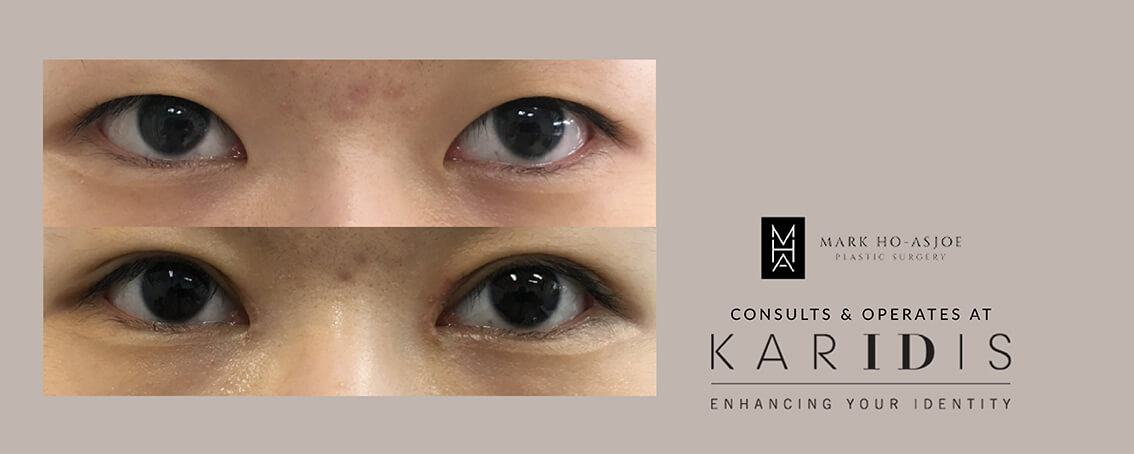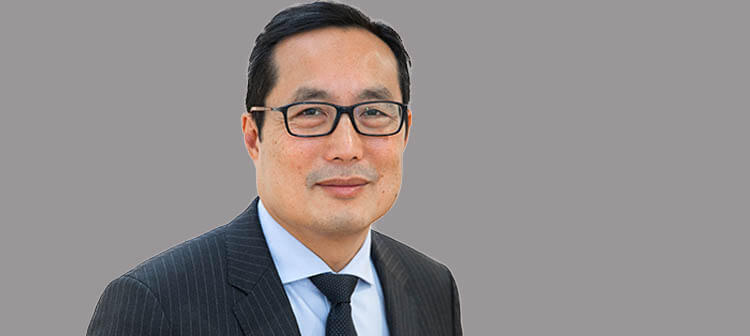What is Asian double eyelid surgery?
Asian blepharoplasty, encompassing double eyelid surgery, epicanthoplasty and lateral canthoplasty, are popular surgical procedures designed to reshape the eye area in Asian patients.
Double eyelid surgery has been performed for over a century although patient aesthetic demands are constantly evolving. Karidis Clinic cosmetic surgeon Mr Mark Ho-Asjoe is highly experienced and skilled in creating a natural crease in the upper eyelid while retaining the patient’s aesthetic and individual ethnic characteristics.
What are the benefits of Asian blepharoplasty?
Around half of the Asian population have no visible upper eyelid crease, known as a monolid, often with thicker skin and larger fat deposits on the upper lid. Double eyelid surgery can make the eye look larger, creating a more refreshed, open appearance.
This unique anatomy of the upper lid can also cause functional problems that can be corrected with double eyelid surgery. The lashes can turn inwards and scratch the surface of the eye. Ptosis of the upper lid can often cause vision problems in older patients.
While medial epicanthoplasty released the epicanthus on the medial aspect, lateral canthoplasty can also be performed to elongate the lateral or outer aspect of the eye and is increasingly popular with younger Asian female patients.
What does Asian eyelid surgery involve?
Asian eyelid surgery involves different options for the incisions, which will be considered carefully during your consultation:
Full incision. If you have excess fat and skin in the upper eyelid, then the full incision might be for you, providing the most permanent results. However, it’s important to note that as this is a full incision across the majority of the eyelid, the scar will be visible (although your surgeon will use skill to locate it so it’s not noticeable to others once healed).
Partial incision. If you have a small amount of excess skin and fat within your eyelids then a partial incision might be a good option for minimal scarring.
No incision. If you don’t have excess skin or fat in your eyelids but desire double eyelids, then this is a useful option with no incisional scar. Instead, your surgeon will create tiny holes to pass sutures through to copy the natural attachments of double eyelids. However, the results might not be long-lasting.
Quick Reference
Quick Links
Leading surgeons
We’re fortunate enough to have Mr Mark Ho-Asjoe as our Consultant Plastic Surgeon. A true specialist in Asian plastic surgery, with more than 25 years of experience, he’s one of London’s most in-demand cosmetic surgeons.
Following his graduation from the Royal College of Surgeons in Ireland, he undertook surgical training in the UK. Having made the decision to specialise in plastic surgery, he continued his learning in the UK and in Taiwan, where he studied at Chang Gung Memorial Hospital – a renowned centre for microsurgical reconstructive surgery.
After years of practice, Mr Ho-Asjoe has built up enough experience to become an examiner for the Diploma of Aesthetics Plastic Surgery. He also sits as an Elected Trustee to the BAAPS Council (British Association of Aesthetic Plastic Surgeons) and is an Honorary Lecturer at Hong Kong’s Queen Mary University Hospital.
He has the experience, skill and expertise to achieve the best Asian plastic surgery results possible.
Mr Ho-Asjoe has such a respected reputation that he’s an examiner for the Diploma of Aesthetics Plastic Surgery. He’s also been elected as an Elected Trustee to the BAAPS Council (British Association of Aesthetic Plastic Surgeons), for 2021 to 2023. In addition, he sits on various other plastic surgery bodies, passing his expertise on and staying up to date with the latest thinking in the sector.
Plus, he lectures on plastic surgery in the UK, mainland Europe and Asia – and is an Honorary Lecturer at Hong Kong’s Queen Mary University Hospital.
FAQS for Asian double eyelid surgery
During surgery, Mr Mark Ho-Asjoe will remove a small amount of excess skin and fat from the upper eyelid, while sculpting a small strip of muscle to form the new crease. Sutures are placed precisely to stabilise and position the eyelid fold.
Choosing a skilled and experienced surgeon is a must as double eyelid surgery is more challenging than a traditional blepharoplasty as you are creating something rather than just trimming skin.
A lateral canthoplasty aims to open the outer corner of the eye. Mr Mark Ho-Asjoe will typically released the corner on the lateral aspect of the eye upper reposition the conjunctiva to widen the horizontal length.
Traditionally, the crease was placed higher to create a more Westernised appearance, but aesthetic demands are constantly changing, and many patients now want a lower crease to retain an ethnic appearance while opening the eye area. Mr Mark Ho-Asjoe will deliver a bespoke result depending on the individual patient’s desires and expectations from surgery.
All surgery carries some risk although they are usually rare. Risks associated with Asian eyelid surgery are similar to standard blepharoplasty and can include infection, scarring, prolong swelling, loosening of the created fold. One of the most common complications can be asymmetry which is why Mr Mark Ho-Asjoe applies meticulous attention to detail in the planning and execution of this procedure.
Any scars will usually be well hidden in the crease that Mr Mark Ho-Asjoe creates. The medical and lateral cantoplasty scar is on the outer corner of the eye and will be more visible. However, it usually heals very well and settled after a few months.
Asian double eyelid surgery before & afters


















